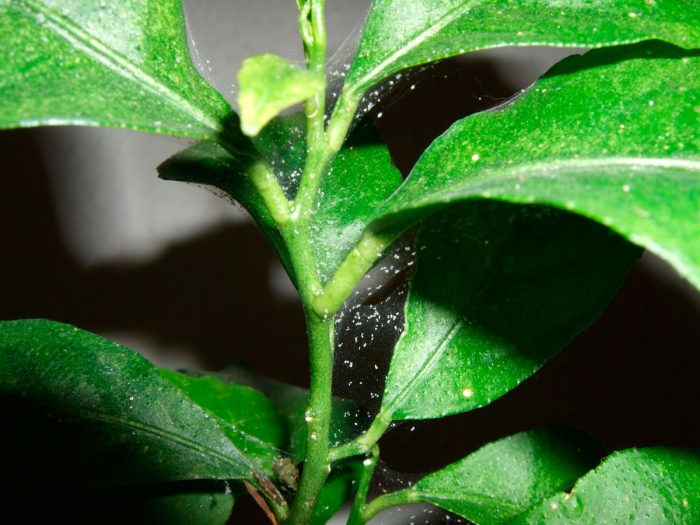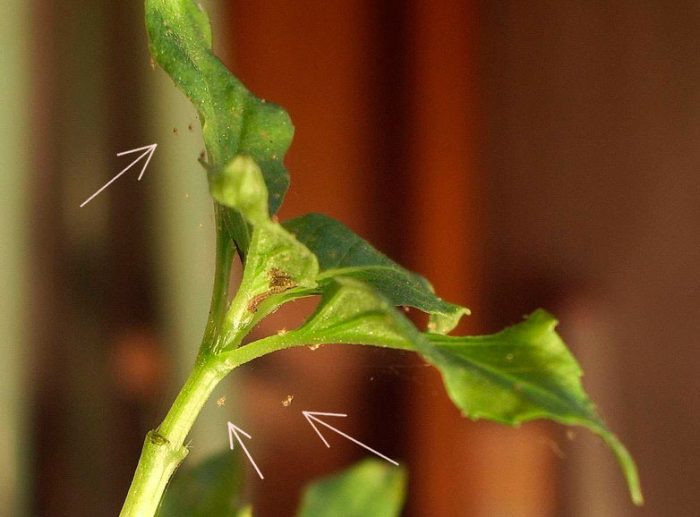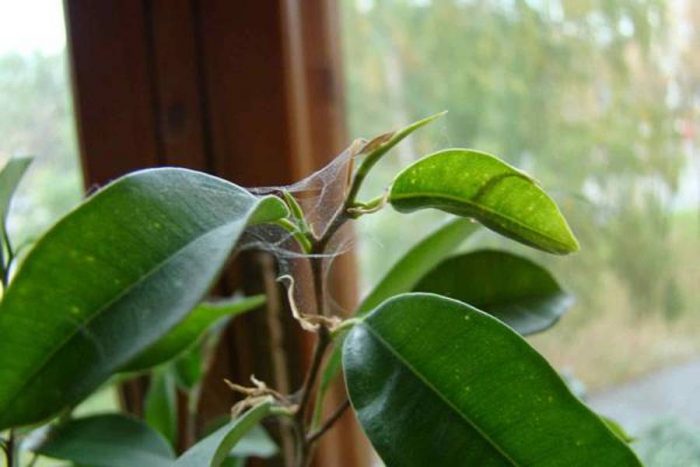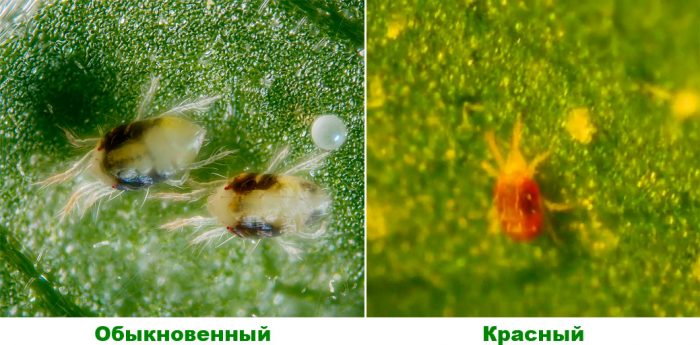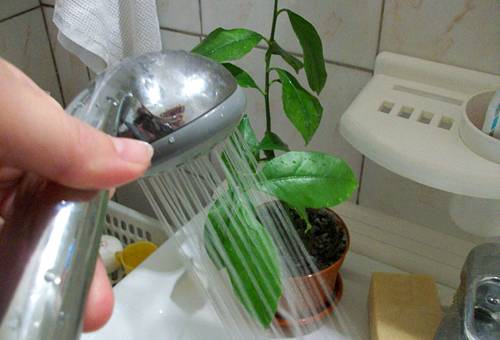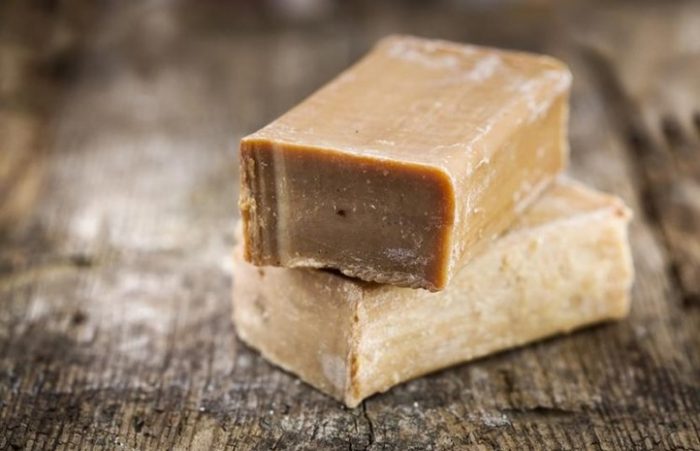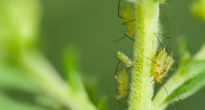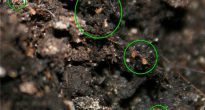Houseplants that decorate the room and help purify the air can be affected by various diseases, and pests often settle on them. The spider mite is just one of these rather dangerous harmful insects. If he settled on a plant, then a cobweb appears on it.
Content
How to detect
The spider mite has a very small size; therefore, it will be extremely difficult to see it with the naked eye. The largest adult specimen has a body length of no more than 5 mm. Depending on the species, the insect can have a different color. Green mites are most common, but they can also be orange or red.
These pests can hide in the soil, in flower pots, or in the leaf axils of the plant. If there are a lot of ticks, then it will not be very difficult to spot them.
Signs of a spider mite
If this pest has settled on your houseplant, then specks of light and pale yellow color are formed on the entire surface of its leaf plates. If there are a lot of pests, then after examining the seamy surface of the leaves, you can see a thin web on it. If the flower is completely covered with cobwebs, then it will dry out quickly.
Spider mite species
There are several types of spider mites:
- Ordinary... This species is most common and poses a great danger to plants. As a rule, such a pest takes refuge on young shoots or on the seamy surface of the leaf plate. Over time, when the number of ticks increases, they will begin to settle on new plants located near the affected one. Such insects are light in color. A cobweb appears on the leaves of the affected specimen, as well as yellow spots.
- Red... A very small pest has a deep red color. This type of tick is the most dangerous of all, but it can not be found as often as an ordinary one. He prefers to settle on orchids, roses and lemon plants.
- Atlantic... This pest prefers to settle where there is a high level of humidity. As a rule, he chooses exotic plants such as palms or citrus fruits.
- False... This insect is very, very small, so it is almost impossible to notice it. Most often, they learn about its presence on a flower only when the plant is covered with a thin web and begins to fade very quickly.
- Cyclamen... Such a soil mite can take refuge both on the tubers and on the leaf plates of the flower. Because of this, it is somewhat more difficult to get rid of this pest than from its counterparts. This species is able to form large colonies, which are often mistaken by a florist for simple dust. In this regard, it is often too late to understand that a plant is affected by such a mite. This pest prefers high humidity.
Spider mite control methods
It is quite difficult to deal with a spider mite that has settled on an indoor flower. To destroy it, flower growers often resort to using folk or special chemicals. It should be borne in mind that it is chemical preparations that are more effective.
But if you are afraid of harming the plant, then in this case it is better to opt for folk methods, time-tested. However, in this case, it should be borne in mind that often these funds are of low efficiency. And, in the end, the grower still has to use chemicals.
Tick control chemicals
A fairly large number of chemicals have been developed that are able to cope with spider mites. Such funds are called acaricides. With the help of them, you can destroy various types of ticks that can settle on flowers grown indoors. For example:
- Actellic... It is used to combat ticks, while this agent is distinguished by a contact effect on the pest. It disrupts the feeding process of spiders, making it impossible. Processing must be carried out 2 times a month. At the same time, the flower grower must wear a special protective suit, and the spraying of the flower must be done either in a non-residential area or on the street, since this drug is very poisonous.
- Fitoverm... This biological preparation is much less harmful than Actellic. This product contains aversectins, which have a neurotoxic effect, and it has a detrimental effect on ticks. When processing, you should also take care of the means of protection, because Fitoverm is also a poisonous agent.
- Neoron... This tool is most effective. During processing, both adult ticks and eggs, as well as larvae, die.
- Flumite... This drug has a detrimental effect on the eggs of spider mites, so that new individuals are not born. Adults also die from this remedy, in this regard, you will be able to completely destroy the pest in a relatively short time. You can spray the plant only once every 4 weeks, since Flumite is highly toxic.
- Skelta... This tool appeared not so long ago, but it has already become popular among flower growers. It destroys both adult insects and larvae. However, it should be remembered that after treatment, adult ticks will die only after 7 days, and larvae - after 5 days. Despite this, Skelta is highly effective, and just one spray is enough to completely destroy the tick.
Folk remedies
It happens that the grower does not want, for various reasons, to resort to the use of chemicals to get rid of spider mites. What should be done in this case? There are many folk remedies, the preparation and use of which is not difficult.
Before starting the fight against spider mites using folk methods, it is necessary to prepare the plant, for this you need to thoroughly clean it. To do this, you need to wash the flower with plain clean water, while the use of detergents is not recommended, as they tend to clog the pores on the leaf blades. Then you need to wash the windowsill, window and pot very thoroughly to remove any pests that may be there.Only then should the plant be treated with your chosen folk remedy. For example:
- Garlic infusion... To prepare it, you need to finely chop a couple of heads of garlic and mix the resulting mass with 1 liter of boiled water. The container must be tightly closed with a screw cap and placed in a cool dark place for 5 days to infuse. Before use, the infusion is diluted with water in a 1: 1 ratio. Then the plant is treated with it.
- Infusion of onions... 5 liters of clean water must be combined with one hundred grams of onion husks. This mixture should be allowed to brew for 5 days. The finished infusion must be drained, and then it can be used to process flowers.
- Alcohol... This folk method has shown a relatively high efficiency. But it should be borne in mind that it can only process flowers that have dense leaf plates. Take a cotton swab and moisten it with ammonia. Then they need to thoroughly wipe the surface of the sheet plates. The effectiveness of this method can be reduced if the ticks are hiding in hard-to-reach places.
- Soap solution... To prepare such a solution, you can take any soap, for example: household, green or tar. Both the affected flower and the container in which it grows should be processed. Leave the foam on the surface of the flower for 2–4 hours. When it is washed off, the flower must be covered with a polyethylene bag, which is removed only after a day. This will maintain the required high level of air humidity.
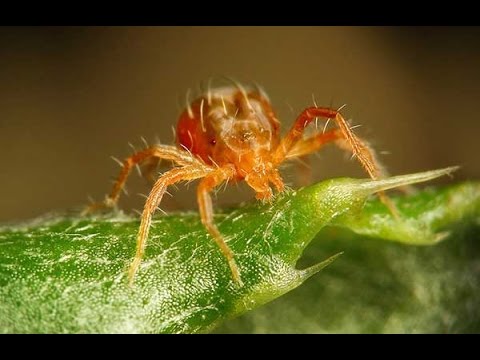

Watch this video on YouTube
Prevention of infection
In order to prevent damage to the plant by a spider mite, preventive measures should be taken:
- systematically inspect all indoor plants;
- this pest prefers dry air, so it is important to maintain the optimal humidity level;
- it is necessary to systematically spray the leaf plates from the sprayer with clean water;
- Once a month, the flower needs to arrange a warm shower;
- recently purchased flowers must be quarantined;
- it is imperative to steam the substrate, since there may be individuals in it that hibernate in the ground.


Watch this video on YouTube

